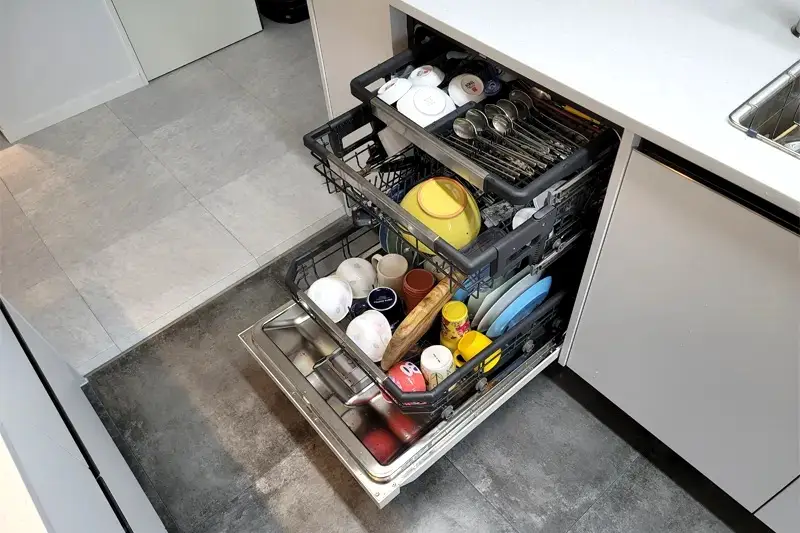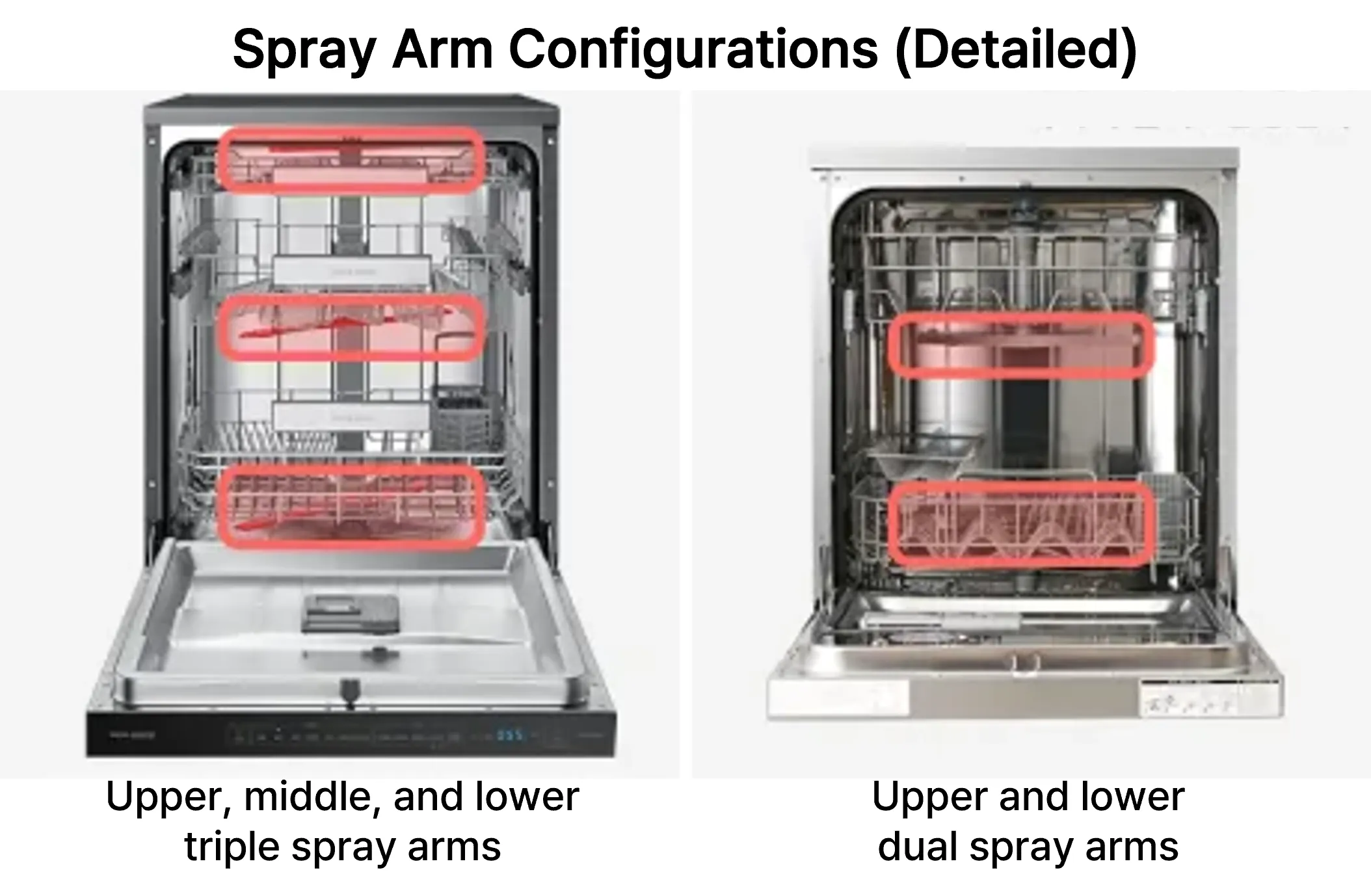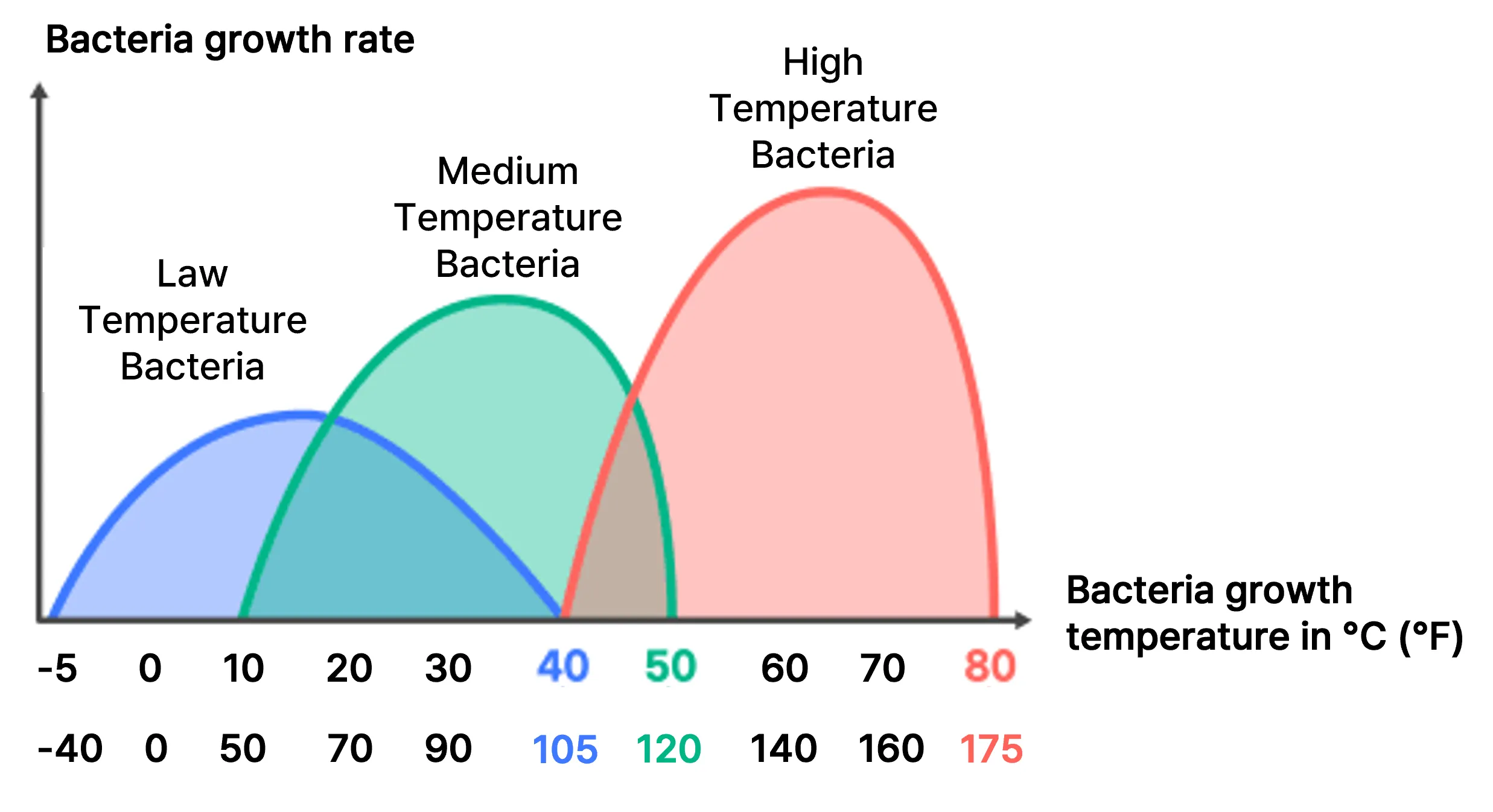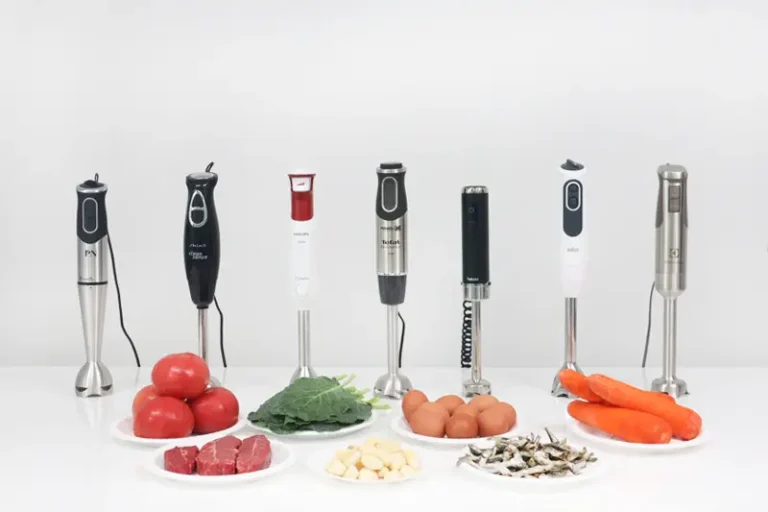The Best dishwashers Buying Guide

Choosing a Life-Changing Appliance: Your Guide to Dishwashers
Dishwashers, capable of automatic washing and drying, are incredibly popular in Europe and the United States, with a penetration rate of up to 70%.
While their adoption rate is still relatively low in some countries, they’re experiencing double-digit growth annually and gaining popularity rapidly. Just as clothes dryers, introduced decades ago, have recently become essential appliances, dishwashers are expected to follow suit.
Let’s explore the effectiveness of dishwashers, how to choose the right one, and proper usage techniques.
Chapter 1.
dishwasher Operating Principles & Effects
How It Works / Effectiveness / FAQ
1. Operating Principle
Food Removal with Strong Water Pressure,
Enhanced Cleaning with Specialized Detergent and Hot Water
High-Pressure Water Spray
for Debris Removal (Physical Action)
Dishwashers use rotating nozzles to spray high-pressure water, removing food debris from dishes.
Specialized Detergent + Hot Water
for Enhanced Cleaning (Chemical Action)

The most crucial elements of dishwasher cleaning are: 1) Specialized detergent 2) Hot water use
- Specialized Detergent:
Dishwasher detergents primarily contain oxygen-based bleach and are more alkaline than regular dish soap, providing stronger cleaning power. While this helps remove food and stains easily, it may damage the coating on some pans or pots, so check manufacturer recommendations. - Hot Water Use:
Dishwashers use water at 131-185°F (55-85°C) to effectively remove grease and other contaminants. This is significantly hotter than the 104-113°F (40-45°C) typically used for hand washing dishes.
Quick Drying through Evaporation Promotion
Depending on the model, dishwashers use 1) condensation drying, 2) fan drying, or 3) heated drying to quickly evaporate remaining water on dishes.
2. dishwasher Usage and Effectiveness
When Used Correctly, Provides Better Cleaning than Hand Washing,
Especially Effective for Grease Removal + Sanitization
Pre-Rinse to Remove Large Debris

Before using the dishwasher, lightly rinse off large food particles under running water.

Without this step: 1)The filter will need cleaning after every cycle 2)Removed debris might stick to other dishes instead of reaching the filter

With pre-rinsing, the filter stays cleaner, requiring only periodic simple cleaning/maintenance.
For Stuck-on Food, ‘Soak or Pre-Scrub’

For dishes with baked-on food, either 1) soak the dishes or 2) lightly scrub (without soap) before placing in the dishwasher.

Without soaking or pre-scrubbing, some stubborn residue might remain after the cycle.
Superior Cleaning Compared to Hand Washing

When used correctly, dishwashers provide more convenient and thorough cleaning than hand washing.

Dishwashers are particularly effective at removing grease due to the hot water, making them great for cleaning range hoods and other greasy kitchen items.
Small Particles May Remain

Even with proper use, very small particles like ground red pepper might occasionally remain after washing.
3. Common Questions about dishwasher
Understanding Pros and Cons Before Purchasing
We’ve compiled answers to the top 10 questions people ask when buying a dishwasher.
Q1. Is pre-rinsing necessary?
A: If used regularly, pre-rinsing is not needed.
Q2. Can it clean even without pre-washing?
A: Dried-on food may not be completely removed.
Q3. Is it safe for crystal glassware?
A: Crystal or heirloom glassware should be washed by hand.
Q4. Can I use regular dish soap?
A: Always use detergent specifically made for dishwashers.
Q5. Will dishes dry completely after washing?
A: Drying effectiveness may vary depending on the dishwasher model.
Q6. Can it remove stubborn stains?
A: Heavy stains can be removed if soaked or pre-treated.
Q7. Does using a dishwasher save time?
A: While it saves time on washing, loading and unloading are still required.
Q8. How much does it cost to run?
A: It costs about $0.09 to $0.19 per cycle on average.
Q9. Can it cause skin allergies?
A: Allergic reactions are rare but possible due to detergent residue.
Q10. How clean is the inside of the dishwasher?
A: Most areas are self-cleaning, but some parts may need occasional manual cleaning.
Chapter 2.
dishwasher Capacity & Types
Choosing Based on Your Household Needs
1. Selecting Capacity
For convenient use, a 12-place setting is recommended
Single-person households can consider a compact 3-place setting model
| Capacity | Type | Price Range (USD) | Recommended For | Dimensions (WxHxD) |
|---|---|---|---|---|
| 12-place | Standard/Built-in | $500-$2000 | 4+ person household | 23.5″ x 32.7″ x 23.5″ |
| 8-place | Standard/Built-in | $500-$800 | 2-3 person household | 17.7″ x 23.6″ x 32.7″ |
| 6-place | Compact | $400-$600 | 2 person household | 21.3″ x 19.7″ x 16.1″ |
| 3-place | Countertop | $250-$300 | 1 person household | 17.1″ x 17.1″ x 16.5″ |
Dishwasher capacities are typically categorized as 12, 8, 6, or 3 place settings. This capacity indicates how many people’s dishes can be washed in a single cycle. For example, a 12-place setting dishwasher can handle dishes used by 12 people in one meal.
A general rule of thumb is to divide the place setting by 3 to get the ideal household size. For instance, a 12-place setting dishwasher is suitable for a family of 4. However, there’s no one-size-fits-all answer, as each household has different dish usage and washing patterns.
Some 2-person households might need a 12-place setting dishwasher, while others find a 3-place setting sufficient. Consider installation requirements when choosing capacity:
Capacity and Dish Load
| Item | 12-Place | 8-Place | 6-Place | 3-Place |
|---|---|---|---|---|
| Dinner Plates | 12 | 8 | 6 | 3 |
| Soup Bowls | 12 | 8 | 6 | 3 |
| Dessert Plates | 4 | 3 | 2 | – |
| Cups/Saucers | 6 | 3 | 2 | 2 |
| Small Plates | 8 | 2 | 4 | 2 |
| Cutlery Sets | 12 | 8 | 6 | 3 |
| Glasses | 6 | 4 | 3 | 1 |
The following information shows the approximate number of dishes each capacity can handle:
- These numbers assume optimal loading. Casual loading might reduce capacity by about 30%.
- Actual capacity can vary based on loading technique and dish sizes.
- Even with the same number of dishes, poor arrangement or insufficient space between items can reduce cleaning effectiveness.
Use this information as a general guide when selecting your dishwasher capacity.
For households of 4 or more:
12-place setting recommended

A 12-place setting model is ideal, allowing you to run the dishwasher after 2-3 meals. If budget or space constraints lead you to choose an 8 or 6-place setting model, be aware that:
- It’s harder to accumulate dishes for fewer loads
- You may have limited space for cookware in addition to dishes
- You’ll need to arrange dishes more carefully for each load
For 2-3 person households:
12-place setting recommended, but 6-8 can be considered

While a 12-place setting might seem large for 2-3 people, it offers:
- More relaxed loading without meticulous arrangement
- Ability to run less frequent, fuller loads

A 6-place setting can usually handle one meal’s worth of dishes for 2-3 people, but may feel limiting if you use many cooking utensils or large pots and bowls.

An 8-place setting can handle 1-2 meals’ worth of dishes, but given the often small price difference from 12-place models, opt for 12 if you have the space.
For single-person households:
Choose between 3 and 6-place settings

Consider your budget, available space, eating habits, and dish usage. A 3-place setting is sufficient for one meal’s dishes if you don’t use many cooking utensils.
If you prefer to accumulate dishes or want more loading flexibility, a 6-place setting might be more comfortable.
2. Choosing the Type
8 and 12-place setting models come in freestanding or built-in types
Check installation methods before purchasing

- Freestanding Type: Fully finished on all sides, allowing for standalone installation (like a refrigerator) or built-in installation under a counter.
- Built-in Type: Designed specifically for under-counter installation, often lacking finished sides.
Note on Under-Counter Installation

When installing under a counter, freestanding models might require modifying the toe kick area. Built-in models often fit without modifying existing cabinetry, preserving your kitchen’s look.
Chapter 3.
dishwasher Cleaning Performance
What Differences Exist Between Products?
1. Washing Effectiveness
Minimal difference in cleaning power between brands
Focus on spray arm configuration

Unlike dryers, which have seen technological advances from gas to electric to heat pump models, dishwashers have maintained the same basic “rotating spray arm” cleaning method for years.
While manufacturers often market superior cleaning power based on spray angles, intensity, or patterns, most users find it difficult to perceive significant differences in cleaning performance between brands.
Consumer Reports Test Results:
Little Difference Among Major Brands
| Brand | Model | Capacity | Cleaning Performance | Drying |
|---|---|---|---|---|
| SK Magic | DWA-3320D | 12 place settings | Good for lightly soiled dishes | Mostly dry |
| LG | D1256MF | 12 place settings | Good for lightly soiled dishes | Mostly dry |
| Miele | G5100SC | 12 place settings | Good for lightly soiled dishes | Mostly dry |
| Siemens | SN25F230E | 12 place settings | Good for lightly soiled dishes | Mostly dry |
While this data is from older models, it’s still valuable for reference. The test showed that most brands left residue on only 1-3 dishes out of a full load, with differences being negligible (e.g., a few stuck rice grains).
Detergent Type May Influence Cleaning Power

Many users report that the type of detergent used has a more noticeable impact on cleaning performance than the dishwasher brand itself.
There’s no one-size-fits-all answer for the best detergent, as preferences vary. If you’re unsatisfied with cleaning performance, try switching detergents before considering a new dishwasher.
Check the Spray Arm Configuration

There are slight differences in spray arm setups between brands and models:
- For 8-12 place setting models: The best configuration is three spray arms (top, middle, bottom). Most recent models have this setup, but some may only have two.

- For 3-6 place setting models: Two spray arms (top/bottom or top/side) are usually sufficient. Some models only have one bottom spray arm, which may result in weaker cleaning for the upper rack.
2. Sanitization Effect
Most dishwashers provide adequate sanitization
Not a major factor in selection
Dishwashers use hot water between 158-185°F (70-85°C) for washing and rinsing, which is much hotter than the 104-113°F (40-45°C) typically used for hand washing. This temperature range can effectively kill most mesophilic bacteria.
Longer exposure to high temperatures improves sanitization

Microorganisms die off when exposed to heat above their growth temperature. Higher temperatures and longer exposure times lead to better sanitization.
Sanitization isn’t perfect,
so it’s not recommended as a primary selection criterion

While higher maximum temperatures can be beneficial, the advantage isn’t significant enough to be a deciding factor. Bacteria can form spores to protect themselves, and complete sterilization (killing all microorganisms and spores) requires temperatures of at least 248°F (120°C) for 20 minutes – beyond the capabilities of household dishwashers.
Dishwashers can effectively sanitize and remove most bacteria, but they can’t achieve full sterilization. However, the 158-185°F (70-85°C) range is sufficient for everyday use and meets food safety standards.
If you want enhanced sanitization
- Look for models with higher maximum temperatures, but be aware that these cycles often take longer.
- Consider models with UV sanitization lamps, although their effectiveness can be limited by factors like dish arrangement and cycle duration.
3. Drying Performance
Most 12-place setting models use condensation drying
6-place setting models use fan drying; little difference between products
While some models offer heated drying for faster results, many newer models avoid this feature due to energy costs and potential fire hazards.
- 12-place setting models typically use condensation drying
- 6-place setting models usually use fan drying
There’s little noticeable difference in drying performance between products.
Condensation Drying (common in 12-place setting models)

This method works by:
- Drawing in the hot steam from inside the dishwasher
- Condensing it into water droplets and draining them away
This lowers the humidity inside, promoting evaporation from dishes.
However, it’s not perfect – some water droplets may remain on dishes. It’s often recommended to leave the door open for about 30 minutes after the cycle for air drying.
Fan Drying (common in 3-6 place setting models)

his method uses a fan to blow air and speed up evaporation. It’s generally less effective than condensation drying.
Chapter 4.
dishwasher User Convenience
Noise / Racks / Cycles / Additional Features
1. Noise
Intermittent noise similar to washing machine drain
Minimal variation between products
During operation, especially when spraying water or draining, dishwashers produce noise similar to a washing machine’s drain cycle.
The noise level is generally not disruptive – it’s barely noticeable if the kitchen door is closed. However, if you’re sensitive to noise or plan to run the dishwasher while sleeping, consider models with a quiet mode or adjustable water pressure settings.
Minimal brand differences
Not a recommended selection criterion
| Brand | Model | Capacity | Noise Level |
|---|---|---|---|
| SK Magic | DWA-3320D | 12-place | 45 dB |
| LG | D1265MF | 12-place | 44 dB |
| Miele | G5100SC | 12-place | 38 dB |
| Siemens | SN25E230E | 12-place | 43 dB |
During operation, especially when spraying water or draining, dishwashers produce noise similar to a washing machine’s drain cycle.
The noise level is generally not disruptive – it’s barely noticeable if the kitchen door is closed. However, if you’re sensitive to noise or plan to run the dishwasher while sleeping, consider models with a quiet mode or adjustable water pressure settings.
2. Rack Configuration
12-place setting models have 2 or 3 racks
3-rack is convenient but not essential

12-place setting dishwashers come with either 2 or 3 racks. Many international brands feature 3-rack designs, while domestic models have traditionally had 2 racks, though 3-rack options are becoming more common.

Smaller 3-6 place setting models typically have simpler rack configurations, with 3-place setting models usually having a single rack and 6-place setting models offering either 1 or 2 racks.
3-rack designs offer more convenient storage

While 2-rack models use a cutlery basket, 3-rack designs have a dedicated top rack for utensils and small items, which many find more convenient. The third rack utilizes otherwise unused space, so it doesn’t reduce capacity for dishes and bowls.
User reviews suggest that while the difference isn’t dramatic, the 3-rack design does offer noticeable convenience. However, as 3-rack models may be less common and potentially more expensive, it’s not considered an essential feature.
3. Additional Wash Options
Models with options for pre-soak, extra rinse,
and drying are more convenient
- Pre-soak: Adds pre-wash cycle to loosen tough stains
- Rinse: Extra rinse cycle for cleaner dishes
- Dry: Additional drying cycle
- Time Delay: Set cycle to start at a later time
- High-Temperature Wash: Increases water temperature for better cleaning
- Steam: Uses steam for enhanced cleaning and sanitizing
- Zone Wash: Option to wash only upper or lower rack
Some dishwashers allow you to add extra steps to the standard wash cycles.
For example, you might add an extra rinse after a normal cycle for cleaner results. While available options vary by model (and some don’t offer additional options at all), features like pre-soak, extra rinse, extended dry, and high-temperature wash tend to be the most useful for many users.
4. Additional Features
Auto door opening enhances user convenience
Among various additional features, the auto door opening function receives the highest user satisfaction. Here’s why it’s beneficial and some alternatives:
| Feature | Description |
|---|---|
| Auto Door Open | Automatically opens door after cycle to improve drying |
| Delay Start | Sets cycle to start at a predetermined time |
| Cycle Options | Add soak, rinse, dry, or high-temp wash to standard cycles |
| Upper/Lower Zone Wash | Option to wash only in upper or lower rack to save water/energy |
| Rack Height Adjustment | Adjusts upper rack height for tall items in lower rack |
| Child Lock | Prevents accidental operation or changes during cycle |
| UV Sanitization | Uses UV light to sanitize dishes after wash cycle |
| Remote Control | Operates dishwasher via smartphone app |
Highly recommended: Auto door opening
After a cycle ends, leaving the dishwasher door closed can lead to poor drying and potential odors or bacterial growth. The auto door opening feature eliminates this concern by automatically opening the door at the end of the cycle. This is particularly useful if you start the dishwasher before leaving home or going to bed. While this feature is often found on higher-end models, many users find it worth the investment.
Alternative: Delay start function
If your preferred model doesn’t have auto door opening, look for one with a delay start function. This allows you to set the dishwasher to finish at a specific time, so you can be ready to open the door when the cycle ends. Most 12-place setting models include this feature.
Half load or zone wash options
Some dishwashers offer the option to wash only the upper or lower rack, which can save time, energy, and water when you have a small load. While this sounds efficient in theory, the actual savings in energy and water are often minimal. Consider whether the effort of carefully arranging dishes in one rack outweighs the small potential savings.






